Teslas now more expensive to recharge using Superchargers than fueling BMW, Mercedes, Lexus
It’s official: A Tesla is now more expensive to recharge than it is to refuel its petrol-powered competitors – at least if you’re using the Tesla Supercharger network.
Since increasing cost of using a Tesla Supercharger to 52 cents per kilowatt-hour the once-clear advantage Teslas had over their petrol rivals has disintegrated.
An EVcentral.com.au analysis of the revised supercharger prices shows the Tesla Model 3 costs $9.78 per 100km if you’re running it on electricity from the much-hyped Supercharger network.
Want the latest EV news and reviews delivered to your inbox? Subscribe to our weekly newsletter!
The rival BMW 330i is $8.00 and the Lexus IS350h $6.76.
Even the thirstier Mercedes-Benz C300 – which matches the 7.0L/100km used as an average fuel use figure on the Tesla website – comes in cheaper than the Tesla Model 3, at $9.66 per 100km.
It seems Tesla’s increasing electricity prices has made the EV sales pitch a fraction tougher.
But it hasn’t stopped Tesla fudging figures to its advantage – all so it can incorrectly claim that charging a Tesla is “less than the cost of petrol”.
Tesla says “the goal of the Supercharger network is to enable freedom of travel for Tesla owners at a fraction of the cost of gasoline”.
However, that is no longer the case. In fact that “freedom of travel” now costs a fraction more than the cost of petrol.
Having just increased the cost of using its Supercharger network from 42c/kWh to 52c/kWh – a 24 percent price rise – the Californian brand is using incorrect or outdated figures on its website when comparing its EVs to petrol-powered rivals.
In spruiking the benefits of its Australian Supercharger network Tesla suggests its cars are almost half the price of a petrol equivalent.
But the numbers used in the calculations are out of date.
The supercharging cost is listed as 42c/kWh, for example. It should be 52c/kWh.
And the price of petrol is listed as $1.75 per litre, an average level it has never hit in Australia.
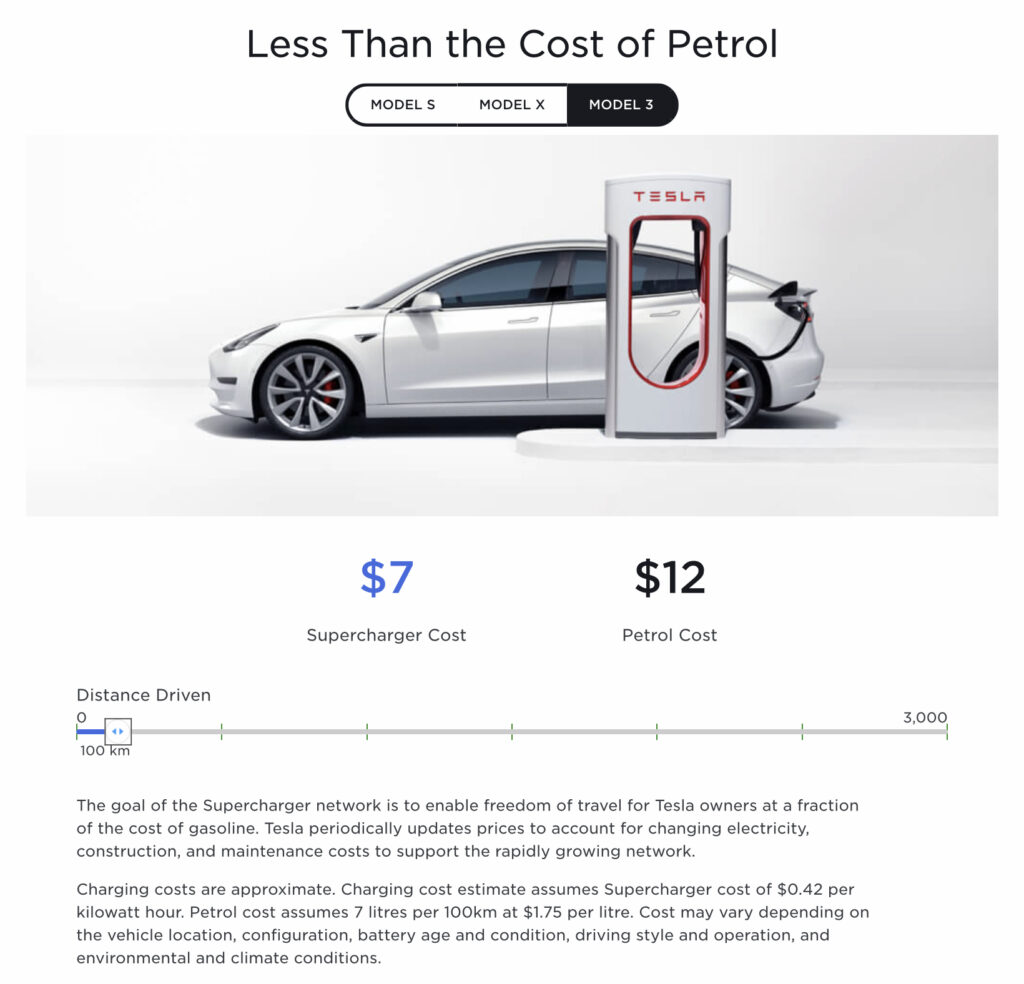
The current average fuel price for unleaded petrol in Australia is about $1.22 per litre, according to the NSW government’s Fuel Check website.
Granted, most Tesla competitors need premium unleaded. But even PULP is well below the Tesla estimate, at about $1.38 per litre.
Plug the up-to-date figures into the calculator and the base Tesla Model 3 Standard Range Plus costs more to charge at a Tesla Supercharger than those rivals refuelling at a petrol station.
Here’s a quick rundown using consumption figures supplied by the respective vehicle manufacturers to the government’s Green Vehicle Guide website:
- Tesla Model 3 Standard Range Plus
18.8kWh/100km at 52c/kWh = $9.78 per 100km - BMW 330i
5.8L/100km at $1.38/litre = $8.00 per 100km - Lexus IS300h
4.9L/100km at $1.38/litre = $6.76 per 100km - Mercedes-Benz C300
7.0L/100km at 1/38/litre = $9.66 per 100km
In other words, the Tesla is more expensive to charge compared to some rivals running purely on petrol – when using the Tesla Supercharger network.
Sure, there’s a lot more to the story.
Being an EV, the Tesla is cheaper to service and most owners will use free chargers or charge at home, where they should be paying 30c/kWh or less (or nothing if they have solar).
Marty Andrews is the CEO of Chargefox, the largest EV charging network in Australia.
He makes the point most EV drivers will charge at home or at their destination, at which point recharging is free or much cheaper than a Tesla Supercharger.
“EVs are cheaper to run because you can locally charge them at home and you can use solar,” says Andrews.
He says the cost of establishing fast charging networks needs to be offset with higher electricity costs.
“The Superchargers and Ultra-Rapid chargers on the Chargefox network are there to support you on a long-distance drive,” he says. “If they end up similar [to the cost of a petrol car] … the average is still going to be way, way lower [than using petrol].”
But it doesn’t excuse the wildly incorrect figures spruiking Supercharging, especially from a company that has been so innovative on so many levels – in turn changing the car market for the better.
Then again, Tesla is not afraid of pushing the boundaries.
It often makes promises on vehicle and technology arrival times that are never met. Full autonomous driving was promised in 2018 and it’s still not remotely close.
Tesla still refers to the circa-$12,000 semi-autonomous driving system as “Full Self-Driving Capability” and its headline prices don’t include luxury car tax, which can sometimes add tens of thousands of dollars to the drive-away price.

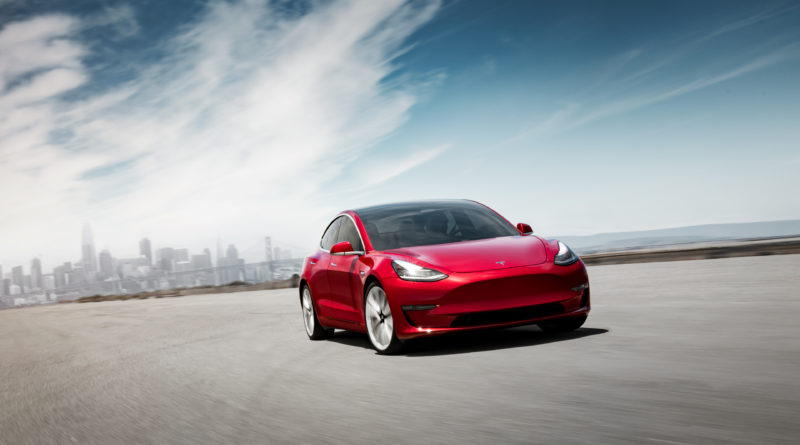
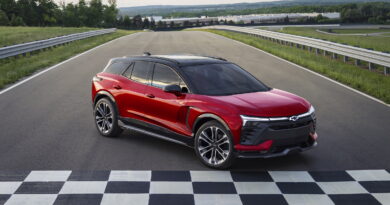
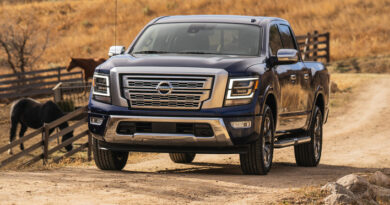
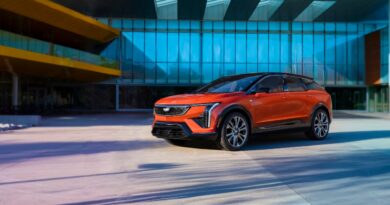
I’m sorry but this is factually incorrect, my Tesla Model 3 Performance which is heavier and has larger wheels therefore more inefficient than the Model 3 SR+ averages less consumption than this article reports and I do not drive the car any different to how I used to drive my other performance internal combustion engines.
Thanks for the comment Chris. The figures are taken from the GreenVehicleGuide website so we could use figures tested to the same standard. As with ICE cars, the GVG figure may vary depending on driving styles and conditions. We were merely using those figures to make a direct comparison.
Generally Tesla drivers have their cars fill up at home at a fraction of this prices, or when shopping, & this is usually free ATM. Supercharging is generally only for intermediate fills on long trips. You’d have a point if those other brands could also fill themselves up while parked at home.
All of which was made clear in the article. The point is that Tesla claims that Teslas are cheaper to recharge on a Supercharger – this is incorrect.
For all other scenarios EVs are almost always cheaper to recharge.
I think the issue is that it’s explained in the article, but it’s the headline that people are going to see and remember – and the headline is inaccurate.
We’ve updated the headline to make it clear we’re talking about recharging at a Supercharger.
I have only ever charged my Tesla from my Solar at home, or at hotel accom from a standard PowerPoint overnight. In over two years I have never paid a cent for running costs, and no service costs either.
It looks like the data on GreenVehicleGuide doesn’t make a lot of sense. It shows the Model 3 long range duel motor using more power (209 Wh/km) than the performance (207 Wh/km). Even with mostly freeway driving and spirited acceleration (With acceleration boost) in a Model 3 LRDM I am at 178 Wh/km over 12,000 km of driving through winter.
Then there is the range which bears no resemblance to their Wh/km assumptions. If you got 620 km in a LRDM that would be 120 Wh/km and at 209 Wh/km you would only get 358km range.
It seems like they are using the highest possible power consumption and the longest possible range. Given that the figures manufacturers use for fuel consumption are notoriously “ambitious” I would think it would be more accurate to use a more realistic Wh/km number for the Tesla.
I drive a model 3 SR+ predominantly in the city and average around 14 kw/100km = $7 to fill up at a supercharger – the absolute most expensive way to charge my car. Not the average way I charge my car. Can you find anyone who drives their Mercedes or BMW at 7l/100km, or are they just bullshit manufacturers figures?
You are kidding about trusting the GVG aren’t you Toby? You do know that they are so far from real world that it is beyond ridiculous. My Model 3 is now 20000km and a solid 140wh/km (the same as the German certified value). There are may papers out of Europe (and my studies of real Australian fleets) that show ICE consumption to be on average 39% more than the GVG, sometimes as much as 100%.
Let’s run the numbers again on that basis.
The author is clearly a Tesla hater 🤦🤦. I think you need to check your facts, the whole article has incorrect figures thru out it which does nothing for your credibility.
We double checked the figures and are confident they are correct. That said, we’re happy to correct them if you point out which ones are incorrect.
There is no LCT on the standard range plus model 3.
Full self driving is currently $10,100 not $12,000.
Tesla even quotes the typical efficiency of the Standard range plus is 150wh/km.
Here’s some info for you to update your article.
Full self-driving is $10,100 before some taxes. With a Model 3 SR+ it pushes the car into LCT territory, albeit only a few hundred dollars. If you tick the FSD option on a Model 3 SR+ it adds about $10,900 to the price you’ll pay. For all other Teslas FSD adds more than $13,000 to the retail price of the car.
Well write it factually, the whole article is based on the SR+. You lose every ounce of credibility when you try and exaggerate the figures to make the article suit your narrative.
Similar calculations apply to other Teslas. We picked one of the popular ones to do the calculations.
But you don’t need to add it at the time you purchase. Wait until delivery and then pay for Full Self Driving and you dont have to pay LCT on it.
You’re figures are way off from my real world experience mate.
This is so flawed – supercharging isn’t the price of your entire trip, let alone ownership. If I drive 1400km in my model 3 perf, 450km of that trip is from my home (solar, or off peak) and another 450km is sourced from where I stay before I drive home. Hotels have always provided this for free in my experience. My last family trip of this distance cost me $10 in charging, the rest was provided for free by hotels.
Find me an 11s car that you can road trip through the NSW countryside with my family, for next to nothing, then please explain to me how this car is expensive to own. Supercharging is for filling the gap, not for every km of use.
The article does not say Teslas are expensive to own. It points out that using a Supercharger to recharge is more expensive than refilling an ICE with fuel.
Actually your title is: Teslas now more expensive to recharge than fueling BMW, Mercedes, Lexus. Again as most owners will attest that much of their “fueling” is done at home and often off solar, my last few weeks of charge sessions have been at zero cost. Show me a Petrol car that you can fuel for nothing. If you’re going to pick the most expensive way to “fuel” a Tesla then you should be picking the most expensive way to fuel a Petrol vehicle.
I have a Model 3 P and it uses around 120kwh per 100km. Also, last time I checked, I couldnt fuel a petrol car off my solar panels at home either. This article is pure clickbait in my opinion.
CVG energy consumption figures for the Model 3 SR+ are rubbish. For comparison the Kona Electric which is heavier and marginally higher Cd is only 13.1kWh/100km.
Agree the GVG figures are not always representative, but it was a way to compare apples with apples. Interestingly the Tesla online calculator suggests electricity consumption of 16.7kWh/100km – it estimates $7 at 42c/kWh, which converts to 16.7kWh/100km.
To add to your claim you would well know that the claimed (manufacturer’s) ICE fuel efficiency doesn’t translate in the real world. But you rely on this to shape the narrative here.
I have a Model 3 SR+ and it has averaged 12.7kWh/100km over 10,000km. This makes the Supercharger cost at $6.60/100km.
Here is some real world data from a Model S (which will be using more electricity than a Model 3SR).
In just over 2 years I have done 66240km which has used 11460 kWh of electricity for an avearge of 17.3 kWh/100km.
Of that 11460 kWh there have been 493 kWh from Superchargers when on road trips (mainly a long trip from Qld to Canberra and return plus some shorter QLD trips). At 52c/kWh that would be $256.36.
Remaining 10967 kWh actually came from a split between home and free public charging (a shopping centre and the local uni both have free chargers that I use when shopping or meeting friends at cafe) but lets assume I only charged at home and didn’t have solar (which I do). 10967 kWh @ 22c/kWh would be $2412.74 (I estimate my actual cost is probably closer to $1000 given much comes from solar which “costs” me 10c/kWh and probably at least 10% free charging at shops).
So $2412.74 + 256.36 = $2669.10 for 66240 km = 4c/km
At $1.20 petrol price that means the equivalent of around 3.33L/100km.
Now remind me again which large sedan from BMW, Mercedes or Lexus does that???
(If you use my actual cost of $1000 it is under 2c/km or around 1.6L/100km equivalent).
180wh/kms is far too high for normal use of M3s and Model Ss.
The members of TeslaWA Slack have posted records of their lifetime wh/kms and these start from 129wh/kms for a SR+
to 139wh/kms for a P3D-
to 151wh/kms for a LR AWD
to 159wh/kms for a P3D+
to 166wh/kms for a S75D
to 172wh/kms for a S100D.
Some P3D+ are in the 170s wh/kms and most Model X are over 180wk/kms
If you wouldn’t mind letting me know how to get the economy figures you claim for the 330i and C300 I’d really appreciate it. I’ve owned both and my average over 50,000 km in each with a 70/30 mix of highway/city driving was about 40% higher than what you quote. Thanks.
We didn’t get those fuel economy figures. They’re calculated to an Australian standard and supplied to the Australian government. Just as the Tesla figures are.
You say Tesla supplied the figure of over 180 wH/km to the Green Car Guide.
I wonder why Tesla would have supplied a figure way above the official WLTP number, when the other manufacturers use a figure close to (but below) the WLTP consumption?
Did you try asking Tesla about that?
We asked a few questions and so far have not received an official comment.
Green vehicle guide figures are simply wrong. I’m averaging 149kWh / 100km so far this month in my Model 3 Performance. The highest monthly average I’ve had is 156.8. Having said that, I’ve only used a Supercharger once and it was free. I typically charge at home from solar and my electricity bill is usually a credit or I charge for free at the shops. After driving over 47,000km I have paid less than $50 to charge. Your story quiet biased.
Wow, I charge my Model 3 SR+ at home for 6c per kWh, and average 140Wh/km, so that’s $0.84 per 100km. More than 95% of my charging is done at home, so this doesn’t really apply. Let me know when you can generate petrol from panels on your roof.
Perhaps with the volume of comments clearly identifying the flawed and biased reporting the author will consider correcting the information?
Perhaps the headline should read: ‘Tesla continues to excel in energy efficiency and cost per KM’.
I’m not sure what information needs to be corrected?
We simply reported the facts as we saw them:
The Tesla website incorrectly assumed supercharger pricing of 42c/km.
The Tesla website used a fuel price of $1.75 per litre.
The official GreenVehicleGuide consumption figures were correctly reported and when calculated with correct fuel/electricity prices showed Teslas cost more to charge – only when using Superchargers. This was made clear in the story. It was also made clear that anyone using home or destination charging would be paying less than an ICE.
Some Tesla owners have stated they better those GVG figures and we have published those comments.
Tesla was asked to comment for the story and declined to. Tesla checked the figures with us but did not say any of our reporting was incorrect.
We’ll certainly be monitoring any developments and will report on them if they are newsworthy.
Toby, thank you for your prompt response.
I note that you’ve received a plethora of comments stating that the kWh/100km figures you have leveraged for the Tesla Model 3 within your article are inaccurate, with genuine real-world experiences easily under 150kWh/100km. If you don’t feel that comments from owners can be defined as factual, then may I suggest that you test drive a Model 3 to further your article through practical research. Surely you would like comfort yourself in the factual accuracy of your reporting?
On the other side of the equation you have used L/100km figures that are known to be biased to the downside. Again, some practical test-drive experience would perhaps be helpful here.
Utilising two incorrect datasets to arrive at a conclusion doesn’t lead to accurate decision making for your reader base. I say this with the lens of being one of those readers.
FYI – drove past a petrol station in Sydney today with 98 Premium priced at 179c.
Debate is always healthy!
I’m not suggesting for a second the figures quaoted by Tesla drivers are false. It’s just we needed to be able to compare figures and they were the ones with the most credibility. Maybe Tesla (which supplied the figures to the government) needs to look at whether those figures are representative and, if not, have them corrected. And at the very least Tesla needs to fix the other incorrect figures on their website. Either way, it looks like there could be a follow-up.
Thanks for your comments!
I’ve only ever charged my Model 3 SR+ at a Supercharger 3 times (during the first 2 weeks when I didn’t have a wall charger installed at home) and the most I paid was AUD$19.78 to charge it from 14% up to 86% That’s a real world figure for you to use in your article about the SR+
Stupid “click bait” title, all done with flawed figures. You obviously hate Tesla’s and perhaps all electric vehicles and will say anything to stop their rollout and get your headline.
After 14 months of ownership of my performance Model 3, my lifetime average consumption is 157Wh/km but remember a performance 3 will use more than an SR+! Two people that I know with SR+ 3’s are achieving significantly better on lifetime use than me- exactly as I’d expect. Furthermore, all 3 of us do much of our charging from solar, AND very rarely if ever need to use Superchargers. Even on a long trip, we leave home with our “free” solar power having filled the battery.
The Green Guide figures are from a source which is very obviously SERIOUSLY flawed, and in the case of the Model 3, just happen to be utter garbage. I wrote to them a good eight months ago quoting this and they weren’t interested- pretty typical of a government agency.
The other thing that is garbage is the litres per hundred kilometres on the ICE cars, surely you know that NOBODY gets anywhere near close to windscreen sticker figures, and yet you’ve used them.
So you’ve used incorrect figures for both ICE and EV, and incorrect assumptions about how they’re actually used, so your article is ….. click bait garbage, and all about the headline. Unimpressed- what’s your agenda!
My model S is much bigger and heavier car and has lifetime average consumption of 171Wh/km. Model 3 uses on average around 140Wh/km travelled. I suggest you guys speak to the owners of these EVs to get real world data and then base your articles on them. I have travelled so far 68000km on sunshine using excess solar power that I would otherwise not be able to feed into the grid nor into home battery storage. Please remember that it is very likely that people who drive EVs have started with solar long time ago and therefore their cost to power their EV is much less (or free) than refuelling combustion engine cars. And you can’t make your fossil juice at home as opposed to solar electricity that is becoming cheaper to generate every day. Electric car is the next most logical step after installing roof top solar and battery storage.
This article reminds me of when Top Gear in 2015 proved that a BMW M3 was more fuel efficient than a Toyota Prius. Although they were a bit more tongue in cheek.
Look at the petrol prices for the last few months, pick the cheapest price,
find the most expensive electricity price, find the most inefficient and unrealistic statistic you can find on Tesla range and find the most efficient and unrealistic statistics on like for like petrol car.
Now let’s look for a scenario where petrol cars would have the most advantage on electric cars, long distance trips, that is where electric cars are the least efficient and petroleum cars are the most efficient
.
With these figures adjust the statistics to the extreme and justify how petrol cars come out slightly on top.
Now make a sensationalist headline, bingo you have your click bait.
You write for a EVcentral, not sure why you are trying to bend the truth against electric cars, this is something you would expect to see written by the fossil fuel industry.
The average petrol price was taken from the NSW government’s Fuel Check website and was up to date when the article was published.
The cost of electricity is what Tesla charges at its own Superchargers. It is a price set by Tesla.
Certainly not trying to bend any truth – just writing a story using facts presented to us.
We love electric cars, including Teslas!
People again state that charging at home via solar is free. Yes but no, solar panels cost a lot of money to install, you have to take that into account. And you only get power from it during daylight and when there are no clouds. (excluding rare and extremely expensive battery solutions).
Charging via solar can-be-cheaper when you are at home during the day (and who is?) but it’s not free.